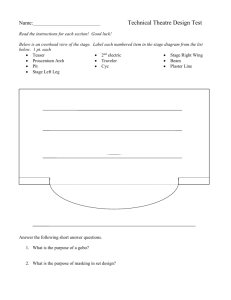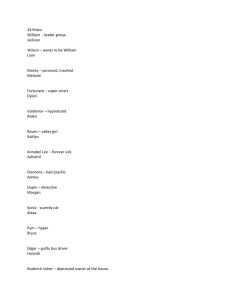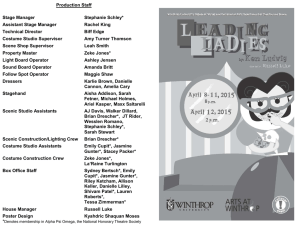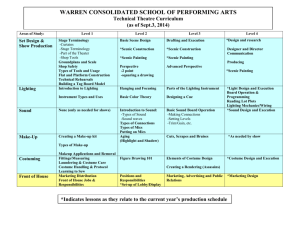SECOND STAGE (PURPLE MASQUE) SCENIC DESIGN CHECKLIST M :
advertisement
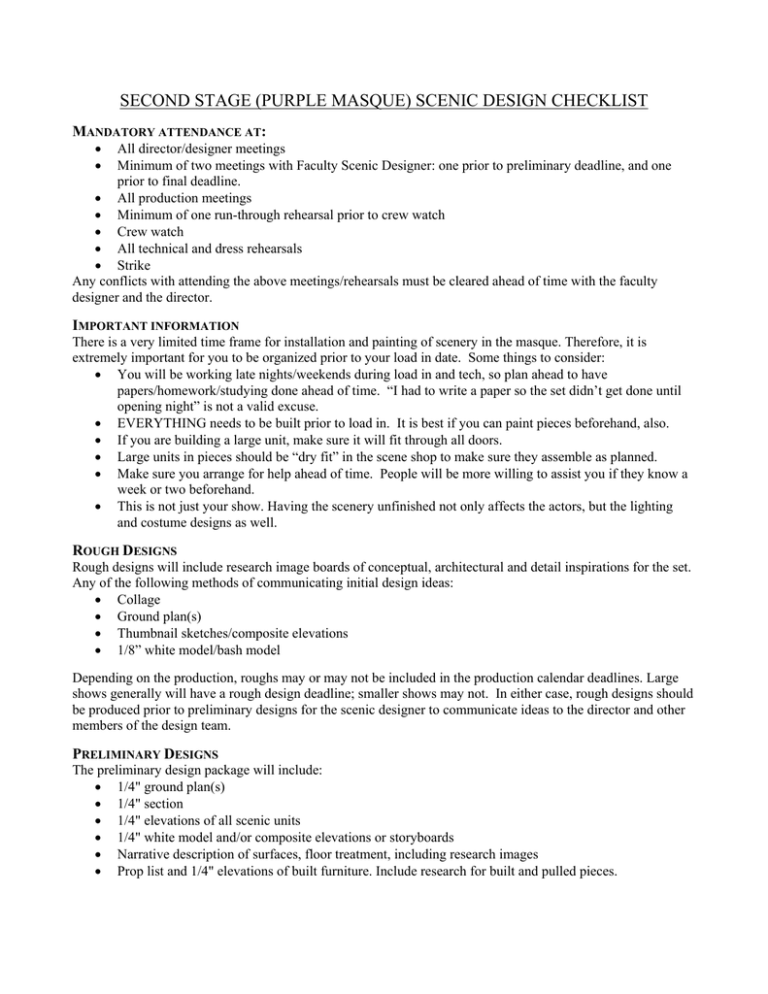
SECOND STAGE (PURPLE MASQUE) SCENIC DESIGN CHECKLIST MANDATORY ATTENDANCE AT: All director/designer meetings Minimum of two meetings with Faculty Scenic Designer: one prior to preliminary deadline, and one prior to final deadline. All production meetings Minimum of one run-through rehearsal prior to crew watch Crew watch All technical and dress rehearsals Strike Any conflicts with attending the above meetings/rehearsals must be cleared ahead of time with the faculty designer and the director. IMPORTANT INFORMATION There is a very limited time frame for installation and painting of scenery in the masque. Therefore, it is extremely important for you to be organized prior to your load in date. Some things to consider: You will be working late nights/weekends during load in and tech, so plan ahead to have papers/homework/studying done ahead of time. “I had to write a paper so the set didn’t get done until opening night” is not a valid excuse. EVERYTHING needs to be built prior to load in. It is best if you can paint pieces beforehand, also. If you are building a large unit, make sure it will fit through all doors. Large units in pieces should be “dry fit” in the scene shop to make sure they assemble as planned. Make sure you arrange for help ahead of time. People will be more willing to assist you if they know a week or two beforehand. This is not just your show. Having the scenery unfinished not only affects the actors, but the lighting and costume designs as well. ROUGH DESIGNS Rough designs will include research image boards of conceptual, architectural and detail inspirations for the set. Any of the following methods of communicating initial design ideas: Collage Ground plan(s) Thumbnail sketches/composite elevations 1/8” white model/bash model Depending on the production, roughs may or may not be included in the production calendar deadlines. Large shows generally will have a rough design deadline; smaller shows may not. In either case, rough designs should be produced prior to preliminary designs for the scenic designer to communicate ideas to the director and other members of the design team. PRELIMINARY DESIGNS The preliminary design package will include: 1/4" ground plan(s) 1/4" section 1/4" elevations of all scenic units 1/4" white model and/or composite elevations or storyboards Narrative description of surfaces, floor treatment, including research images Prop list and 1/4" elevations of built furniture. Include research for built and pulled pieces. The purpose of the preliminary design is to communicate the overall scenic design aesthetic to the director and other members of the production team, as well as communicating the scenic designer’s vision to the technical director for budgeting purposes. The preliminary design will be revised as needed to address any artistic and/or budget concerns to create the final design package. FINAL DESIGNS The final design package will include: 1/2" ground plan(s) 1/2" section(s) 1/2" shift plot (if needed) 1/2" design elevations of all scenic units 1" architectural details, decoration and built props. Painters elevations of all surfaces, drops, and floor treatments (usually in 1" scale.) ¼” or ½” scale model or perspective rendering. A 1/2” scale color model may substitute for paint elevations (include sample paint surfaces in full scale as needed). Prop list Set dressing specifications Upholstery samples The purpose of the final design package is to communicate the final scenic design as agreed upon by the director and all designers for the production, and to provide accurate information to the technical director for the successful construction of all scenic elements. Any changes to the final design package must be approved by the director, scenic designer and technical director. Drafting scale applies to hand-drafted plates; digitally produced drawings may be saved as PDF files and shared with director, stage manager, and other design team members as appropriate. Digital renderings and other color information should be printed by the designer to ensure correct color reproduction. OTHER REQUIREMENTS Masque shows have a lump sum budget. Designer must work with other designers, props master and marketing to determine how to equitably divide the budget. Design must be approved by Director, Faculty Scenic Designer, and Faculty Technical Director prior to final due date and before beginning construction. Designer will be responsible for building, installation, and painting of all scenery. Some shop labor is available for Purple Masque shows. You may want to find volunteer help if necessary. Designer must arrange for time to build in the scene shop by contacting the Faculty Technical Director and/or Scene Shop Supervisor. Scenery installation usually begins the Thursday before crew watch. Any scenery needing to be installed prior to this date must be cleared with the TD and theatre faculty who teach in the space. All props/furniture must be checked out through the Purple Masque manager. Designer is responsible for returning space to black and making sure props are returned to appropriate storage during strike. Students who are completing a Masque design for Practicum credit should turn in all research, prelim and final materials as well as photographs of finished design in order to receive a grade. These materials can be turned in after the show closes. Any student who fails to follow the rules and requirements laid out in this document will forfeit their right to design another Masque show. SECOND STAGE (PURPLE MASQUE) LIGHTING DESIGN CHECKLIST MANDATORY ATTENDANCE AT: All director/designer meetings that involve lighting and/or production concept discussions. Minimum of two meetings with Faculty Lighting Designer: one prior to preliminary deadline, and one prior to final deadline. All production meetings Minimum of one run-through rehearsal prior to paper tech. Minimum of two run through rehearsals prior to Crew Watch. Paper Tech, must be completed prior to drawing Light Plot. Crew watch Cue Set Dry Tech. All technical and dress rehearsals Lighting Checks Strike Any conflicts with attending the above meetings/rehearsals must be cleared ahead of time with the faculty lighting designer and the director. IMPORTANT INFORMATION There is a very limited time frame for rigging lights and writing cues in the Masque. Therefore, it is extremely important for you to be organized prior to your rigging/focus date. Some things to consider: You will be working late nights/weekends during rigging, cue set and tech, so plan ahead to have papers/homework/studying done ahead of time. “I had to write a paper so the lights didn’t get done until opening night” is not a valid excuse. EVERYTHING needs to be planned prior to rigging. Consumables must be ordered one week prior to rigging. The area lighting and a side wash are part of the standard plot. These instruments may not be moved or refocused. Concentrate on color selection and specials. It is not safe to work on ladders alone. Always have a partner when you rig lights. PRELIMINARY DESIGN PACKAGE (see Production Calendar for due dates): Research image boards Cue List with all lighting changes described and located in the script. ¼” or ½” rough Light Plot with location of all scenic elements and furniture, instruments, channels, etc. Brief concept statement Light Plot and schedules must be approved by Faculty Lighting Designer and TD as well as director prior to completing final package. FINAL DESIGN PACKAGE (see Production Calendar for due dates): ½” Light Plot with location of all scenic elements and furniture, Instruments, Gels, circuits, gobos, channels, etc. ½” centerline section showing vertical lighting angles. Lighting Cue list Cue Number, Cue Description, Cue Location, and Cue Fade Time. All necessary supporting lighting schedules (can be done on Lightwright) Copies of the Light Plot & Schedules should be provided to the director, stage manager, and scenic designer. OTHER REQUIREMENTS Masque shows have a lump sum budget. Designer must work with other designers, props master and marketing to determine how to equitably divide the budget. Design must be approved by Director, Faculty Lighting Designer, and Faculty Technical Director prior to final due date and before beginning rigging. Designer will be responsible for all rigging, focusing and setting cues. Some Class Lab labor is available for Purple Masque shows. You may want to find volunteer help if necessary. Know your schedule soon enough that you are not working alone. Designer must arrange for time in the theatre with the Director, Scenic Designer and Faculty Lighting Designer or his representative. Remember the theatre is not available during classes. Lighting installation usually begins the Monday before crew watch. All cues should be in the board by Crew Watch. Lighting Designer is responsible for returning chairs to normal class configuration when chairs are moved and make sure house lights, rehearsal lights and the ghost light function after all work calls, tech/dress rehearsals and performances Any broken instruments, burnt out lamps, or other problems should be reported to the Faculty Lighting Designer or Lighting Assistant ASAP. Students who are completing a Masque design for Practicum credit should turn in all research, prelim and final materials as well as photographs of finished design in order to receive a grade. These materials can be turned in after the show closes. Any student who fails to follow the rules and requirements laid out in this document will forfeit their right to design another Masque show. NOTE: Nichols Theatre and McCain design projects are similar. However, since there is no standard plot in either facility, work must start earlier. All projects need to be approved by the Faculty Lighting Designer prior to execution. SECOND STAGE (PURPLE MASQUE) SOUND DESIGN CHECKLIST MANDATORY ATTENDANCE AT: All director/designer meetings that involve lighting and/or production concept discussions. Minimum of two meetings with Faculty Sound Designer: one prior to preliminary deadline, and one prior to final deadline. All production meetings Minimum of one run-through rehearsal prior to paper tech. Minimum of two run-throughs rehearsals prior to Crew Watch. x Paper Tech, must be completed prior to finishing sound design. x Crew watch Cue Set Dry Tech. All technical and dress rehearsals Sound Checks Strike Any conflicts with attending the above meetings/rehearsals must be cleared ahead of time with the faculty lighting designer and the director. IMPORTANT INFORMATION There is a very limited time frame for setting sound and writing cues in the Masque. Therefore, it is extremely important for you to be organized prior to your rigging/setup date. Some things to consider:You will be working late nights/weekends during rigging, cue set and tech, so plan ahead to have papers/homework/studying done ahead of time. “I had to write a paper so the sound didn’t get done until opening night” is not a valid excuse. EVERYTHING needs to be planned prior to rigging. A stereo house feed is standard in the Masque. It is possible to mount two effect speakers on the stage or in the theatre. There are two CD players available in the Masque. Other equipment must be requested and may not be approved. PRELIMINARY DESIGN PACKAGE (see Production Calendar for due dates): Research Marker Cues Rehearsal CD with necessary effects and preliminary music. Cue List with all Sound Cues described and located in the script. Block Diagram of all components required for the design. Desired equipment List. Brief concept statement Sound Plot and schedules must be approved by Faculty Sound Designer and TD as well as director prior to completing final package. FINAL DESIGN PACKAGE (see Production Calendar for due dates): ½” Ground plan with location of all scenic elements and furniture, & speaker locations. ½” centerline section showing vertical speaker placement. Sound Cue list Cue Letter, Cue Description, Cue Location, and Cue Fade Time. All necessary supporting sound schedules All final CD’s or sound files required to run and backup final design. Operational Cue list indicating levels and fades. Copies of the Sound Plot & Schedules should be provided to the director, stage manager, scenic and lighting designers. OTHER REQUIREMENTS Masque shows have a lump sum budget. Designer must work with other designers, props master and marketing to determine how to equitably divide the budget. Design must be approved by Director, Faculty Sound Designer, and Faculty Technical Director prior to final due date and before beginning rigging. Designer will be responsible for all rigging, recording and setting cues. Some Class Lab labor is available for Purple Masque shows. You may want to find volunteer help if necessary. Know your schedule soon enough that you are not working alone. Designer must arrange for time in the theatre with the Director, Scenic Designer and Faculty Sound Designer or his representative. Remember the theatre is not available during classes. Sound installation usually begins the Wednesday before crew watch. All cues should be planned and running by Crew Watch. Any problems should be reported to the Faculty Sound Designer ASAP. Students who are completing a Masque design for Practicum credit should turn in all research, prelim and final materials as well as photographs of finished design in order to receive a grade. These materials can be turned in after the show closes. Any student who fails to follow the rules and requirements laid out in this document will forfeit their right to design another Masque show. NOTE: Nichols Theatre and McCain design projects are similar. However, since the sound systems are more complex in either facility, work must start earlier. All projects need to be approved by the Faculty Sound Designer prior to execution. SECOND STAGE (PURPLE MASQUE) COSTUME DESIGN CHECKLIST As the Costume Designer for a Purple Masque production, you have the following responsibilities: 1. To provide the director with a character/costume design that reflects the director’s production concept/artistic approach. Your design must be based on: A. Your script and character analysis. B. Your participation in design development with the director and other members of the design team. During these discussions, the group will work together to form insights into the ideas, themes and meanings of the script, and discuss ways to support them visually via sets, lights, costumes and staging. C. Thorough visual and text-based research into cultural and social context or the script, as well as costume research based on character, status, economic level and historic era. D. Physical constraints of available time labor and budget. (Resources) 2. To organize and complete the physical production of all costume elements, including wigs and make-up. Approaches to this include: A. Creating and updating a complete costume plot, which lists all items each character wears including wigs and accessories. B. Creating a Pull / Purchase / Build list which will include each item in the show. This must be done as soon as the design is developed, and will prove invaluable for project management. C. Obtaining accurate measurements and personal information for each actor. D. To keep up to date information about all sources of costumes, so that each item can be returned to its appropriate place. E. Identify all unusual or craft needs as early as possible and discuss with advisor methods of meeting these needs. F. Create a Costume Bible that contains all show information in one location for easy reference. This is usually done with a tabbed, three ringed binder. All research and a copy of the script should also be a part of this bible. G. Create a costume calendar with deadlines that you set with input from your advisor and the director. This should include fitting deadlines, pull deadlines and due dates for all necessary paperwork, including plots and fast change schedules for wardrobe crews. H. Scheduling fittings (through the stage manager), and being prepared for them by having all available items ready. The more organized and prepared you are, the more your actors will respect you. 3. Maintain your costume budget. A. Create a budget breakdown. You do this by taking your initial budget figure (given to you by the director or your advisor), remove 10% as a contingency fund, estimate dry cleaning for items that can’t be washed (figure about $3-$5 per item) and remove that. What you end up with is your budget. Analyze your script and plot for # of costumes required and divide into your budget amount. This is your per costume allowance. Now look and see if you have any specific items that you know you will have to purchase to support your design. Can you adjust your figures to accommodate this? You may need to go back to the director and ask him/her to re-evaluate the amount given you. This should be discussed in the design meetings. Finalized budgets are to be reviewed with advisor on the budget due date listed in calendar. You are expected to remain on top of your budget. B. Create a budget sheet. The format is up to you, but you need to be able to record the following information for each purchase: date, item purchased, production, requisition #, vendor, amount, method used for purchasing and running total of expenditures. You must get a requisition from Karen in the main office for every purchase, and you are not allowed to make any purchases until you have met with your advisor and learned purchasing procedures. NEVER throw away receipts and always make a Xerox copy of them; they must be turned in to Lori within 24 hours of purchase with the requisition # on them. C. Always know where you are on your budget. 4. Organize the costumes and your paperwork for the Wardrobe crew. Be prepared for Crew Watch, Load-in and Dress rehearsals. A. Attend a full run-through of the production the week before tech (at least; try to attend the first full stumble-through). Make notes about costume changes; where they have to happen, how long you have to make them, do the actors have to “travel” to make their next entrance, etc. Incorporate these notes into your costume plot to create a “running plot”; this is what you will give the wardrobe crew. This is also the time to point out to the director any problems with staging that can be easily fixed to help with wardrobe changes. Earlier in the rehearsal process is better than later to discuss this, and don’t be surprised if the Director does not want to change something. B. At the beginning of Crew Watch, discuss professional behavior with both the crew and cast. This includes respect for costumes, and the actors responsibility to hang them up and report maintenance notes, respect for each other’s need to focus on their jobs before, during and after the show, and cleanliness in the dressing area. C. Direct your crew’s attention towards any costume changes during the Crew Watch. D. During Load-in (usually Sunday of Tech), all costumes must be labeled (including shoes, t- shirts and tights). A costume inventory/check-in/out book must be created by the crew, including pre-set lists for changes if necessary. Laundry responsibilities are assigned at this time; all costumes with labeled ditty bags, iron and ironing board, inventory sheets, wigs, etc are taken to Masque dressing room. If a quick-change rehearsal is necessary, this is the day to do it; it may require doing your load-in earlier in the day or on Saturday. E. First Dress. Be there at the same times as your crew is called an guide them through their first inventory. Watch them do their pre-sets. Be available and APPROACHABLE for the actors to ask you questions, but remember that by the next dress, the questions should go to the crew, then to you. Work with the crew too so that they will be comfortable dealing with actor questions and issues. Remember that everyone is having a lot of new information thrown at them in one night, you included, so it is ok to be stressed. Just try to keep a sense of humor. F. During the following dress rehearsals, your job is to back away from the running of the show in gradual steps, allowing the crew to assume more responsibility. G. Strike. You need to be prepared for strike by knowing what needs to be dry-cleaned, hand washed or laundered. You also must see to the return of all costume items after cleaning, either to stock or the person/place from which they came. 5. To deliver and maintain the artistic integrity of the Costume Design within the production concept. Direct methods of this include: A. Creating a visual means of communicating your design to the Director, design team and cast (for main-stage, costume shop) that is clear and understandable. Your method of communication is up to you (renderings, collages, etc), but it must reflect the concept of the show as well as your character ideas and specific costume design. B. Attend all design and production meetings and actively participate in all discussion; you are not limited to the costume area, and should not be surprised if others discuss costumes. However, take copious notes of all costume-related discussions in meetings...these will become very important. C. Include the Director and other members of the design team as much as possible; invite everyone down to look at completed costumes. Solicit feedback within boundaries; keep an open mind, but decide what you feel is important. D. Include the actor as much as possible and ask for information about movement, action or staging that could impact costume. Discuss your vision of the character with them and answer any questions they might have. Most actors want to look GOOD; your job is to make them look like the character. The better the actor understands this, the better they will look. Never underestimate the value of your time spent in fittings. E. Dress rehearsals are your only chance to edit and polish your design in full sale. Take notes and pay attention. Meet with the director every evening to discuss notes. Your director has a very strong interest in how his/her characters look, and it is important to respect that. Make changes as quickly as possible; the more times you can review/correct your design, the better it will be. MAINSTAGE COSTUME DESIGN CHECKLIST All the above remains the same with the following inclusions. 1. Preparation and design process. You are required, as a main-stage designer, to expand the depth and breadth of your research, script and character analysis. You are to identify all areas of knowledge about which you need to educate yourself, and gather the information that you need to create a competent and confident costume design. You should be able to maintain well-informed discussions about relevant topics with all members of the production team. 2. Shop Construction process. As a main-stage designer, you will be required to interact with the costume shop for alterations, fittings, crafts and primary construction. While we consider it to be part of your learning process to help educate you on construction, you are also expected to come into the process prepared to discuss silhouette, period cut, known staging requirement of costumes (choreography, special effects, etc). You need to be prepared to have informed discussions with the cutter/draper, and have either cutters sketches or specific research for all constructed costumes (including crafts). 3. Wig/Make-up You will be responsible for the design of all wigs, make-up style and special effects. You will work with the actors during tech to convey this aspect of the design. 4. Schedule With the help of your advisor and the costume shop manager, you will establish the construction and crafts calendar which establishes due dates for each major aspect of the shop process. WHAT YOU HAVE A RIGHT TO EXPECT AS A COSTUME DESIGNER. 1. An organized Director, with a clear directorial approach and research-based knowledge of the script and its context. 2. An organized Stage Manager that provides on time daily and production reports, with clear readable notes, questions and fitting schedules, contact information, rehearsal information and production calendar. The Stage Manager should also be expected to respond in a timely manner to requests submitted by the Costume Designer. 3. A Faculty Mentor that will meet with you several times during the design process, attend dress rehearsal(s) and be available for emergencies or general support. NEVER hesitate to contact your advisor; that is why they are there. 4. A Design Team committed to the collaborative process; enthusiastic and hard- working. 5. An assigned wardrobe crew to handle the run of the show. Remember: You are NOT expected to have all the answers, but you ARE expected to ask for help. You can’t do this on your own.
